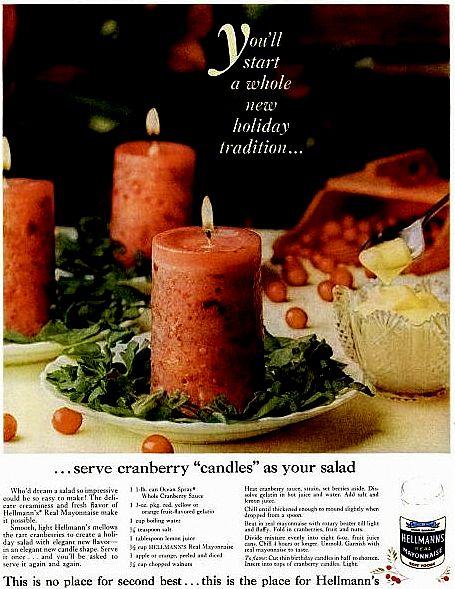This story first appeared on VICE Quebec.With the holidays coming up fast, a lot of us are gearing up for the many traditional feasts that await us. But when discussing classic holiday foods with colleagues, I noticed that most of our families have at the very least one super shady dish, that we seem to only keep on the table for the sake of tradition. From salads in aspic (that meat jelly thing) to sandwich loafs, there seem to be an endless list of weird foods that get prepared around this season, and that can all be traced back to cookbooks dating from the 50s to the 70s.
Advertisement
Pick up any Cold War-era cookbook and you’ll find outlandish dishes like ham-wrapped bananas slathered in hollandaise or Jell-O and tuna pie. In hindsight, it’s easy for our generation of foodies to find this stuff weird, or downright gross. And yet, those dishes were, at the time, culinary revolutions.But this begs the question: why was the food so weird then?

Subtleties: a medieval tradition
Advertisement
Fish in aspic. Image via Wikipedia Commons
On a smaller scale, chefs in the Middle Ages loved presenting cooked fish encased in aspic, to give the impression that the fish were swimming. Aspics are clear jellies made from clarified animal-based stock, and saturated with collagen, a natural gelling agent present in animal bones. At the time, pulling off a perfect aspic was unbelievably difficult, time-consuming and expensive, so it was mostly a way for a chef to show off their culinary skills. It is suggested that some of these dishes weren’t even meant to be eaten, they were simply there to show how that the host had enough money to pay for the ingredients, hire a team to execute the dish, and not even have to eat it. It was the fumbling beginnings of food as an artistic performance.Extravagant dinners stayed popular for most of the Renaissance and spread throughout Europe and North America, where the elite tried to adapt culinary trends of the old country to their new reality.At the beginning of the 1800s, during the Napoleonic wars, French pastry chef Nicolas Appert won a government contest by coming up with a way of cooking foods in glass hermetic glass jars, preventing it from spoiling, making it a perfect way of feeding the troops. After the war, the population slowly started getting richer. The concept of a middle-class starts becoming clearer, and a lot of these people have no idea what rich people eat. Myriad cookbooks and etiquette guides get published, and thus is born the concept of cocktail dinners as we’ve come to know them, with tiny sandwiches with the crust cut off and crudités with dips.
The Victorian Reign of Canned Foods
Advertisement
For the main meal, of course, the host wants to impress. Cookbook authors go back and get inspired by trends of yore, and subtleties make their way back into pop culture. The Industrial Revolution also brings in a number of new culinary techniques. Gelatin is more affordable than ever, seasonal vegetables are available all year-long thanks to canning, and same goes for exotic ingredients, such as pineapple,e which quickly became a favorite in the West.Near the end of the 1800s, industrialization is booming. After the end of the First World War, most homes have electricity, and an increasing number of families have access to a gas stove and a refrigerator. All these new inventions make a homemaker’s job easier, and the main goal becomes to make everything clean and efficient. Jellied dishes become the perfect food: they allow moms to create dishes formerly associated with the elite while using leftovers and canned food. It’s cheap, aesthetically pleasing (by the standards of the day), and relatively easy to prepare. This is when the still popular jellied salads began to appear.With the food industry already scrambling to come up with new and cheap ways to feed the population during the Great Depression, the Second World War forced them to kick into high gear. Canned foods like Spam and other filth once again proved useful to feed the troops. It was gross but weirdly reminiscent of home for the soldiers, and it quickly became sentimental for them.
Post-war Culinary Traumatisms
Image via Pinterest
Advertisement
After the war, all the companies that had made tons of money feeding the army had no intention of slowing down production. So what could they do with surplus and, more importantly, how could they convince people to eat their subpar products rather than real, fresh food? Thankfully for them, the zeitgeist was on their side. Soldiers came back from the war with a newly acquired taste for their products, and women were integrating the workplace in droves. Cheap and quick to prepare, products offered by companies like Heinz, Jell-O and Hi-Liner were perfectly adapted to this new reality.However, food manufacturers noticed that while the times were changing, mentalities were staying the same. Even though women were no longer stuck at home, putting food on the table every night was still her responsibility. And wives felt that serving ready meals to their families would make them bad wives.Ever wondered why you have to add an egg to Betty Crocker cake mixes? At one time, you only needed to add water, but consumers at the time felt that they couldn’t really take credit for making a cake if all they had done was add water to a mix. By adding an egg to the process, they could feel satisfied with their purchase of the cake mix.It is in this sort of mindset that gross post-war food appeared: for mothers to not feel bad for buying pre-prepared foods, they had to use them in more inventive ways. So food manufacturing giants published sponsored cookbooks showcasing different ways to use their products by the dozen. Jell-O, particularly, was able to capitalize on the low prices of their products and the nostalgia women felt toward the aspics prepared by their grandmothers in the Victorian era. Spam was able to take advantage of the fact that soldiers had grown used to the weird taste of their canned meat. And, most importantly, they bet on exoticism. In a weird way, people were coming back to the subtleties of the Middle Ages. For a modest price and with a fraction of the work required before, you could host guests and impress them with exotic delicacies, spectacular techniques and unusual dishes. The problem is that by trying to boost their sales and shoving their products down peoples’ throats, companies came up with the most outlandish dishes, such as edible cranberry jelly candles.
Advertisement
We are what we eat, as they say, and popular dishes of the past are a reflection of the society that let them flourish. Though post-war years give us flashbacks of meatloafs shaped into igloos and way too many dishes based on some form of Jell-O product, it is also the era that let foreign cuisines flourish in North America. It’s when we first got introduced to Asian food, pizza and other favorites.Dishes we now find disgusting have the same sentimental values for our grandparents’ generation (the first generation, it must be noted, who were able to eat for pleasure rather than subsistence) as do Dunkaroos, Pepsi Blue or the Double Down for us.So, keep that in mind when the sandwich loaf is brought out at your holiday dinner. It might not be aesthetically pleasing or on brand enough for your Instagram, but it is, nevertheless, a modern culinary marvel.Follow Billy on Twitter.

